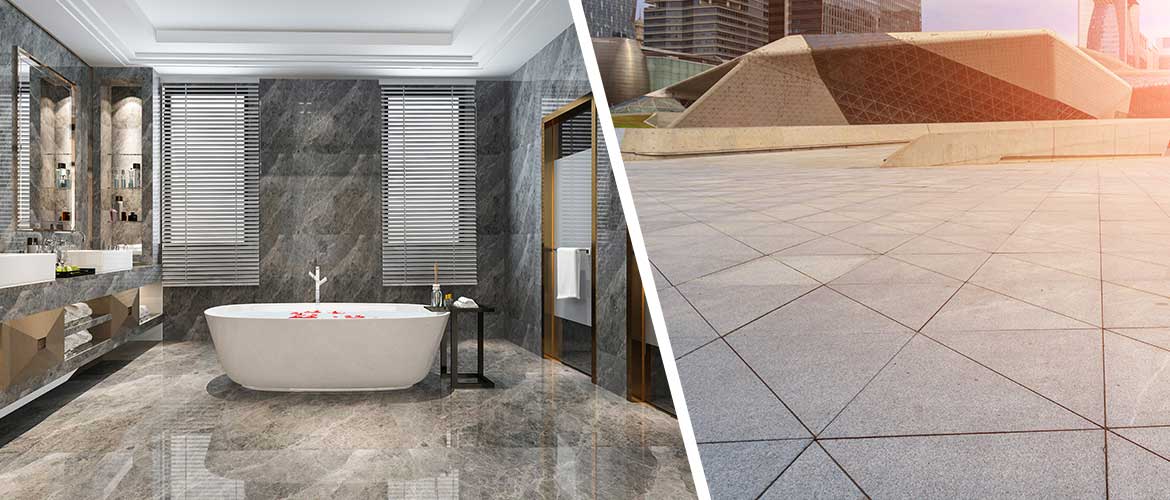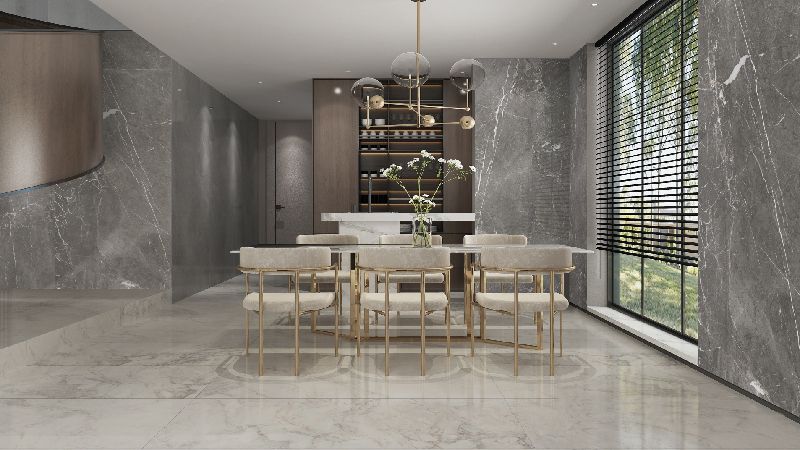Very often, customers use the terms – porcelain and ceramic – interchangeably when referring to tiles. Are both these tiles the same? After all, both ceramic and porcelain tiles are installed for similar applications and have overlapping benefits and drawbacks. Is there really a difference between both?
Emperors Vitrified Porcelain is one of the top ceramics and porcelain tile supplier in India. Join us as we explore the key differences between these two tiles so that you can choose the right one for your home renovation or construction projects.
How to distinguish between ceramic and porcelain tiles?
Ultimately the differences between both comes down to the water absorption rates.
What is a porcelain tile?
Porcelain Tiles have a water absorption rate of 0.5% or lower. To achieve this absorption rate, porcelain tiles use a special kaolin clay. Kaolin clay is purer and finer than ceramic clay. Besides kaolin clay, porcelain tiles also have significant levels of feldspar and quartz mixed with the clay.
- A porcelain tile is fine-grained, dense and smooth. It’s more resistant to water than a regular ceramic tile.
What is a ceramic tile?
Ceramic tiles use a coarser clay compared to porcelain tiles. Unlike porcelain tiles, there are no additives added in ceramic tiles. They are generally fired at lower temperatures compared to porcelain tiles. Unglazed ceramic tiles absorb water more than porcelain tiles.
Differences between Porcelain and Ceramic Tiles: At a Glance
Features | Porcelain Tiles | Ceramic Tiles |
Composition | Fine Kaolin clay | Coarse clay |
Water Absorption | 0.5% or less | More than 0.5% |
Typical Use | Indoor and outdoor floors and walls | Primarily for indoor floors and walls |
Hardness | Hard and brittle | Soft when compared to porcelain |
Resistance to water | Excellent | Good |
Now, let’s compare Ceramic and Porcelain tiles on various characteristics
1. Appearance
Appearance wise, both ceramic and porcelain tiles are very similar, making them indistinguishable to the naked eye.
- Recently, porcelain tile printing technology has advanced significantly. Today, porcelain tiles are available in various patterns like – natural stone, wood and other materials.
- Ceramic tiles on the other hand are generally available in solid colours or patterns.
Winner: If you’re looking for natural wood or stone finish tiles (without the limitations of wood) then porcelain tiles are your best choice.
2. Water and Heat Resistance
Both porcelain and ceramic tiles are equally resistant to water and heat and can even be used on countertops.
- Porcelain tiles are ideal for outdoor locations, as it is more impervious to water when compared with ceramic tiles.
Winner: Tied
3. Maintenance and Care
Both ceramic and porcelain tiles are easy to clean. Spills and stains can be cleaned by damp mopping it with a mild soap solution.
Winner: Tied
4. Durability
Porcelain tiles are more dense and less porous when compared to ceramic tiles. This makes them moisture-resistant and harder compared to ceramic tiles. Also, since the colour and composition are spread throughout the tile body, it’s considered more durable and long-lasting. It’s ideal for areas with heavy usage. Even if a porcelain tile chips, the colour remains the uniform throughout, thereby making cracks invisible.
Ceramic tiles, on the other hand, reveal another colour when the outer layer chips or cracks. Also, as they are less dense, they are not ideal for areas with heavy foot traffic.
Winner: Porcelain Tiles
5. Installation
Both porcelain and ceramic tiles are installed using similar methods. The tiles are first laid to a cement board using adhesives. Once the tiles are set, the joints between the tiles are filled using grouts. While both ceramic and porcelain tiles are installed using similar methods, ceramic tiles are slightly easier to install, since they are softer and easier to cut.
Winner: Ceramic tiles, get a slight edge.
6. Cost
Porcelain tiles require more materials to manufacture and hence the retail costs are a bit higher.
Winner: Ceramic Tiles
7. Lifespan
Both porcelain and ceramic tiles are durable, provided you follow the right maintenance procedures.
Winner: Tied
The Verdict: Which is the winner? Porcelain or Ceramic Tiles?
Well, there is no clear-cut winner. Both porcelain and ceramic tiles have their pros and limitations. They are both suitable for floors, walls and countertops. Ultimately, choosing between porcelain and ceramic boils down to your particular aesthetics – choose whichever tile appeals to you visually. For more info and prices of ceramic and porcelain tiles, reach out to our team here at Emperors Vitrified Porcelain. As one of the top porcelain and ceramic tile supplier in India, we can help you find the perfect floor and wall tiles that match your specific needs.









